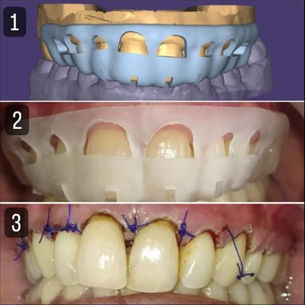
Consulting Specialists
At our clinics, consulting specialist treatments include:
Pedodontics
A specialty focused on diagnosing, treating, and preventing dental issues in children from birth to adolescence. Our Pedodontist takes special care in educating the patients and their guardians to maintain proper dental hygiene.
Treatments include:
- Pit and fissure sealants and Fluoride applications (preventive care)
- Fillings
- Extractions
- Pulpotomy/Pulpectomy
- Dental Crowns
- Space Maintainers
- Special Care Dentistry
- Full Mouth Rehabilitation in Early Childhood Caries (ECC)
Periodontics
A specialty focused on treating conditions that affect the tissues around your teeth, such as bone loss, gum recession, and periodontal (gum) disease.
Lasers in periodontics: Our clinics specialize in treatments with soft tissue lasers, which are less invasive and painless, with negligible bleeding.
Treatments include:
- Deep Scaling and Root Planing
- Periodontal Flap Surgery
- Crown Lengthening
- Gingivectomy (Gummy Smile Correction)
- Gum Depigmentation (Gum Bleaching)
- Frenectomy
Orthodontics
Orthodontics is a specialized branch of dentistry focused on diagnosing, preventing, and treating dental and facial irregularities, known as malocclusions. These can include issues such as crooked teeth (crowding), deep bites, crossbites, and misaligned jaws.
Orthodontic treatments often involve the use of braces, aligners, and other dental and myofunctional devices to correct these problems, aiming to improve both the function and appearance of the teeth and jaws.
Treatments include:
- Braces: Traditional metal braces, involving brackets attached to teeth connected by wires that are periodically tightened to gradually move teeth into the desired position. There are also ceramic braces, which are less visible.
- Clear Aligners: These are transparent, plastic forms of dental braces used to align teeth for age groups starting from 7 years and above. They provide an aesthetic alternative to traditional wire braces with the advantage of being removable.
- Retainers: After the main phase of orthodontic treatment, retainers are used to keep teeth in their new position. They can be removable or fixed to the teeth.
- Space Maintainers: If a child loses a tooth early through decay or injury, a space maintainer is used to keep the space open until the permanent tooth erupts.
- Surgical Orthodontics: Also known as orthognathic surgery, it is used to correct severe cases of malalignment involving the jaw, which cannot be treated with braces alone.
- Interceptive Orthodontics: Serial extractions, crossbite correction, diastema closure, control of abnormal oral habits, and space retainers.
Oral & Maxillofacial Surgery
Oral and maxillofacial surgery is a specialized field of dentistry that focuses on the diagnosis and surgical treatment of diseases, injuries, and defects, involving both the functional and aesthetic aspects of the hard and soft tissues of the oral and maxillofacial region.
This area includes the mouth, jaws, face, and neck.
Treatments include:
- Tooth Extractions: Includes the removal of damaged or impacted teeth, such as wisdom teeth/mesiodens.
- Corrective Jaw Surgery: Procedures to correct a range of minor and major skeletal and dental irregularities, including the malalignment of jaws and teeth, which can improve chewing, speaking, and breathing.
- Facial Trauma: Repairing facial injuries, including fractures of the jaw and face, and reconnecting severed nerves or ducts.
- Cleft Lip and Palate Surgery: These are birth defects that affect the upper lip and the roof of the mouth. The surgery involves multiple procedures to improve the function and appearance of the lip and palate and enable normal eating, speaking, and breathing.
- Cancer-Related Surgeries: Includes the removal of tumors and reconstruction of the affected areas of the mouth, throat, neck, and face.
- TMJ Disorders: Treatment for temporomandibular joint disorders.
- Cyst enucleation: This treatment is a surgical procedure used to remove cysts, which are sac-like pockets of membranous tissue containing fluid, pus, or other material from the jaws or around the teeth.
Endodontics
Endodontics is a specialized branch of dentistry that deals with the study and treatment of the dental pulp and the tissues surrounding the root of a tooth.
Treatments include:
- Root Canal Therapy (RCT): This is the process of removing infected, injured, or dead pulp from the tooth’s canal. The space is then disinfected, shaped, filled, and sealed to prevent further infection.
In our clinics, RCTs are performed using rotary-driven machines, apex locators, and Niti files with rubber dam isolation.
- Endodontic Retreatment (Re RCT): If a previous root canal therapy fails, retreatment involves reopening the tooth to remove the previous root canal filling material, disinfecting the canals, refilling and resealing the canals.
- Endodontic Surgery: This includes procedures like Apicoectomy (removal of the tip of the root and sealing the root end), which may be needed when inflammation or infection persists in the bony area around the end of your tooth after a root canal treatment.
- Trauma Management: Treatment of teeth that have been knocked out (avulsed), displaced, or fractured. Endodontic treatment can help save such teeth and restore them to function.
- Cracked Teeth: Treatments to manage various types of cracks that affect the health of the tooth pulp.
- Internal Bleaching: A cosmetic procedure performed on teeth that have undergone root canal treatment, to lighten or remove discolorations within the tooth structure.
Prosthodontics
Prosthodontics is a specialized branch of dentistry that focuses on designing, manufacturing, and fitting artificial replacements for teeth and other parts of the mouth.
This specialty involves the restoration and replacement of damaged or lost teeth with fixed or removable prostheses. The prostheses not only restore function and aesthetics but also help to maintain the proper alignment of remaining teeth and facilitate overall oral health.
Treatments include:
- Dental Crowns: Lithium Disilicate (Emax), zirconia, Porcelain fused to Metal (PFM), full metal (Cr-Co), and Metal with ceramic facing crowns.
- Dental Bridges: These structures are used to replace one or more missing teeth, bridging the gap created. Bridges are anchored on neighboring teeth or dental implants.
- Dentures: Complete Dentures (CD), Removable partial dentures (RPD), Cast partial dentures made from Cr-Co framework (CPD), Flexible dentures, and Implant.
- Maxillofacial Prosthetics.











